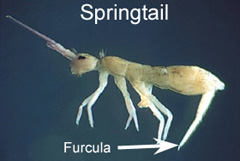Springtails
 Springtails are typically 1/6 to 1/5 inch long and wingless. They get their name from the ability to catapult themselves through the air by means of a forked tail-like structured called a furcula, which is attached on the underside of the abdomen. The ability to “leap” in the air often leads people to assume that these are small fleas.
Springtails are typically 1/6 to 1/5 inch long and wingless. They get their name from the ability to catapult themselves through the air by means of a forked tail-like structured called a furcula, which is attached on the underside of the abdomen. The ability to “leap” in the air often leads people to assume that these are small fleas.
They can be found almost everywhere outdoors. They live primarily in the soil, in leaf mold, organic mulches, under tree bark, in decaying logs, and may even infest potted plants. They are most abundant in damp or moist areas.
Typical indoor springtail sites are usually not obvious. The most common areas where they’re being found are your sources of moisture, such as around exterior doors and windows, in sinks, bathtubs and around commodes. In many cases, springtails may be so numerous around sinks and tubs that people assume that the insects are coming out of the drains. Springtails may also enter the living areas of a home from the crawlspace. The insects are often reported in and around new commercial and residential construction, possibly because they were brought in with freshly spread topsoil and mulch. In some cases, springtails may crawl onto construction materials stacked at a job site and may be accidentally “built in” to a house under construction. However, when construction is completed and humidity levels drop indoors, the springtails should die off.
Springtails play an important ecological role as decomposers. They also feed on algae and fungi and a few species may damage commercial mushrooms and seedlings in hotbeds and greenhouses.
Possible Springtail Sites Indoors:
-
wet plaster or new wallpaper
-
“green”, damp lumber
-
plumbing leaks around/under sinks
-
floor drains
-
over watered house plants
-
leaky patio doors
-
roof leaks
-
sweating pipes
-
moldy mattresses or stuffed furniture
-
condensation around windows
When these sites remain continuously damp and build up a surface layer of mold, they provide the conditions that allow springtails to build up and thrive indoors.
Getting rid of springtails is usually as simple as drying out the site/area and fixing the conditions that caused the high moisture.


































































